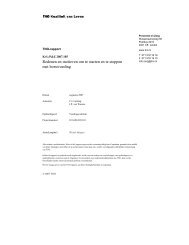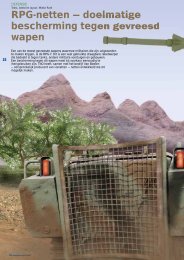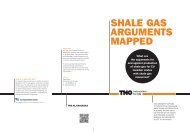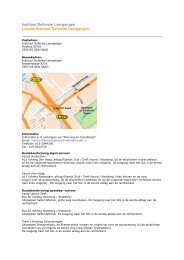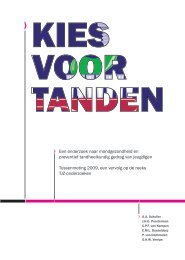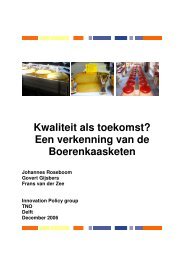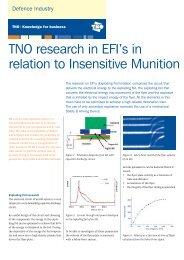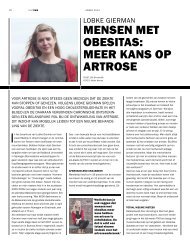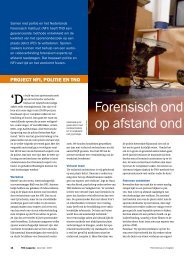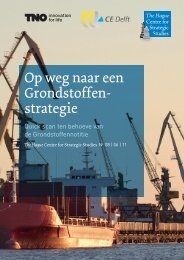A. Eijk Flow and Structural Dynamics (PULSIM) TNO Institute of ...
A. Eijk Flow and Structural Dynamics (PULSIM) TNO Institute of ...
A. Eijk Flow and Structural Dynamics (PULSIM) TNO Institute of ...
You also want an ePaper? Increase the reach of your titles
YUMPU automatically turns print PDFs into web optimized ePapers that Google loves.
COST-EFFECTIVE AND DETAILED MODELLING OF COMPRESSOR MANIFOLD<br />
VIBRATIONS<br />
A. <strong>Eijk</strong><br />
<strong>Flow</strong> <strong>and</strong> <strong>Structural</strong> <strong>Dynamics</strong> (<strong>PULSIM</strong>)<br />
<strong>TNO</strong> <strong>Institute</strong> <strong>of</strong> Applied Physics (T PD)<br />
Delft, The Netherl<strong>and</strong>s<br />
ABSTRACT<br />
In systems with large reciprocating compressors, so-calIed compressor manif\)ld<br />
vibrations can contribute to fatigue failure <strong>of</strong> the pipe system. These vibrations are<br />
excited by pulsation-induced forces <strong>and</strong> by forces generated by the compressor.<br />
This paper describes an advanced <strong>and</strong> accurate method for predic- ting vibration levels<br />
<strong>and</strong> cyclic stresses in critical parts <strong>of</strong> the pi- ping, based on detailed modelling <strong>of</strong> the<br />
pulsations <strong>and</strong> compres- sor parts. Although detailed finite element modelling is applied.<br />
the method can compete in ease <strong>of</strong> use with analytical methods <strong>and</strong> is far more accurate.<br />
The effectiveness <strong>of</strong> this approach will be demonstrated by a case study in which a<br />
detailed compressor manifold vibration analysis has been carried out.<br />
INTRODUCTION<br />
Reciprocating compressors are used in gas transportation. gas storage <strong>and</strong> in the<br />
process industry. The compressor, including the pulsation dampers <strong>and</strong> connected pipe<br />
work. is <strong>of</strong>ten the heart <strong>of</strong> an installation <strong>and</strong> should therefore operate reliably. Pulsations<br />
<strong>and</strong> vibrations may disturb safe <strong>and</strong> reliable operation. To avoid vibration problems <strong>and</strong><br />
to optimize the dynamic behaviour, it is common practice to carry out a so-calIed<br />
pulsation <strong>and</strong> mechani- cal response study during the design <strong>of</strong> an installation. Such studies<br />
include investigation <strong>of</strong> compressor manifold vibrations. which are the vibrations <strong>of</strong><br />
compressor cylinders. di stance pieces, crosshead guides, pulsation dampers <strong>and</strong> piping<br />
near the compres- sor. Especially for larger compressors, compressor manifold vibrations<br />
are important as the mass <strong>of</strong> compressor parts <strong>and</strong> pul- sation dampers increases.<br />
which leads to low-resonance frequen- cies which may be excited by pulsation forces. by<br />
gas forces in the compressor cylinder, <strong>and</strong> by unbalanced forces <strong>and</strong> moments <strong>of</strong> the<br />
compressor (Palazzolo, Smalley <strong>and</strong> Lifshits, 1985, Lifson <strong>and</strong> Dube 1987). We have<br />
encountered several actual cases in which pulsation forces have excited compressor<br />
manifold vibrati- ons <strong>and</strong> caused fatigue failure.<br />
The importance <strong>of</strong> calculations <strong>of</strong> compressor manifold vibrations is also retlected in the<br />
fourth edition <strong>of</strong> the API St<strong>and</strong>ard 61 R<br />
J.P .M. Smeulers<br />
<strong>Flow</strong> <strong>and</strong> <strong>Structural</strong> <strong>Dynamics</strong> (<strong>PULSIM</strong>)<br />
<strong>TNO</strong> <strong>Institute</strong> <strong>of</strong> Applied Physics (T PD)<br />
Delft, The Netherl<strong>and</strong>s<br />
415<br />
PVP-Vol. 328. <strong>Flow</strong>-lnduced Vibration<br />
ASME 1996<br />
G. Egas<br />
<strong>Flow</strong><strong>and</strong> <strong>Structural</strong> <strong>Dynamics</strong> (<strong>PULSIM</strong>)<br />
<strong>TNO</strong> <strong>Institute</strong> <strong>of</strong> Applied Physics (T PD)<br />
Delft, The Netherl<strong>and</strong>s<br />
(11).<br />
In this paper, a method for the prediction <strong>of</strong> compressor manifold vibrations<br />
is discussed, which is based on rigorous finite element modelling <strong>of</strong> the<br />
compressor parts. Despite rigorous modelling, the method is efficient <strong>and</strong><br />
easy to" use <strong>and</strong> more accurate than the usual analytical methods.<br />
Before going into detail about the method, a short overview <strong>of</strong> the pulsation<br />
<strong>and</strong> mechanical response study will be given. fol- lowed by a description <strong>of</strong><br />
the kind <strong>of</strong> compressor manifold vi- brations which may occur.<br />
The paper concludes with a description <strong>of</strong> a case study, in which the accuracy<br />
<strong>of</strong> FEM roodels <strong>of</strong> compressor parts has been asses- sed by means <strong>of</strong> modal<br />
analysis measurements.<br />
PULSATION AND MECHANICAL RESPONSE STUDY<br />
Pulsation <strong>and</strong> mechanical response studies have become ac- cepted as part <strong>of</strong> the<br />
process <strong>of</strong> designing a reliable instalIation free <strong>of</strong> vibration problems. Such studies are<br />
carried out by the <strong>Flow</strong> <strong>and</strong> <strong>Structural</strong> <strong>Dynamics</strong> Department <strong>of</strong> the <strong>TNO</strong> <strong>Institute</strong> <strong>of</strong><br />
Applied Physics T PD, also known by the name <strong>PULSIM</strong>. The <strong>Flow</strong> <strong>and</strong> <strong>Structural</strong><br />
<strong>Dynamics</strong> Department is specialized in thé dynamics <strong>of</strong> pipe systems <strong>and</strong> has carried out<br />
some 600 studjes over a period <strong>of</strong> 25 years.<br />
In the study, a two-step approach is folIowed. In the first step, the pulsations, e.g.<br />
pressure <strong>and</strong> tlow velocity waves in the pipe system <strong>and</strong> tluid machinery are calculated,<br />
including pulsation- induced vibration forces. The layout <strong>of</strong> the pipe system <strong>and</strong> the<br />
design <strong>of</strong> pulsation dampers are harmonized to minimize pulsati- on levels <strong>and</strong> forces.<br />
In the pulsation study, worst-case situations are calculated, which means that aII resonant<br />
conditions in a certain range around the nominal condition are investigated. Calculated<br />
amplitudes <strong>and</strong> phases <strong>of</strong> the forces which act on the system at elbows, T -joints,<br />
reducers, pulsation dampers etc., are stored so that they can be used later in the<br />
mechanjcal response study <strong>of</strong> the pipe system.<br />
The pulsatjon study js carried out using the djgjtal sjmulation en- vironment <strong>PULSIM</strong><br />
(pJ.!L.sation SIMulatjon), whjch has been de- veloped by the <strong>Flow</strong> <strong>and</strong> <strong>Structural</strong><br />
<strong>Dynamics</strong> Department <strong>of</strong> the T PD. In general, <strong>PULSIM</strong> is a simulation envjronment for<br />
one-
dimensional non-stationary flow. Besides the functionality for pul- sation<br />
studies, other non-stationary flow phenomena, such as tran- sients, can also<br />
be modelled in the <strong>PULSIM</strong> environment (Smeulers, 1988. Egas, 1988, Van<br />
Bokhorst <strong>and</strong> Korst, 1993, Van Bokhorst, 1995).<br />
In the second step. the mechanjcaJ response study. vjbratjonal res- ponse <strong>of</strong> the pjpe<br />
system. jncludjng pulsatjon dampers. js calcu- lated on the basjs <strong>of</strong> predjcted pulsation<br />
forces.<br />
In the mechanjcal response studjes. a finjte element model js made <strong>of</strong> the pjpe system<br />
<strong>and</strong> the supportjng structure. The finjte element program ANSYS (14) js used for thjs<br />
purpose.<br />
In the mechanjcal response studjes. the pu1satjon forces used have been calculated wjth<br />
the <strong>PULSIM</strong> program. A Ijnk js made be- tween the <strong>PULSIM</strong> <strong>and</strong> ANSYS programs. so<br />
that the ampljtude <strong>and</strong> phase <strong>of</strong> the calculated pulsatjon forces can be transferred to the<br />
ANSYS program for a11 the jmportant acoustjc resonance<br />
condjtjons (worst-case condjtjons).<br />
COMPRESSOR MANIFOLD VIBRATIONS<br />
Compressor manifold vibrations are a specialized <strong>and</strong> com- plicated form<br />
<strong>of</strong> vibration <strong>of</strong> part <strong>of</strong> the piping, pulsation dampers <strong>and</strong> compressor parts<br />
such as cylinders, distance pieces <strong>and</strong> cros- shead guides. If not proper I y<br />
controlled, these vibrations can cause fatigue failure <strong>of</strong> the system. Figure l<br />
shows an example <strong>of</strong> a compressor manifold. Some <strong>of</strong> the common<br />
compressor manifold vibrations have special narnes <strong>and</strong> are summarized as<br />
follows:<br />
Low mode<br />
This mode is shown in figure 2 <strong>and</strong> is generally the lowest mode <strong>of</strong> the compressor<br />
system. This mode is a rigid body mo- tion <strong>and</strong> the cylinders <strong>and</strong> dampers vibrate inphase<br />
horizontally to the combined flexibility <strong>of</strong> the distance piece <strong>and</strong> the crosshead<br />
guide. As the nozzles must twist to accommodate this motion, high torsional stresses in<br />
the cylinder nozzles can occur.<br />
Rotary mode<br />
This mode is shown in tigure 3. The suction <strong>and</strong> discharge<br />
dampers move out-<strong>of</strong>-phase in a horizontal direction. In this mo- de, high bending<br />
stresses can occur, <strong>and</strong> the highest stress points are at the cylinder flanges <strong>and</strong> in the<br />
joints between bottIes <strong>and</strong> nozzles (named branch connections).<br />
Cylinder resonance mode<br />
This mode is shown in tigure 4. The cylinders move out-<strong>of</strong>- phase relative to each<br />
other. With more than two cylinders, vari- ous combinations <strong>of</strong> one cylinder moving<br />
out-<strong>of</strong>-phase in relation to the others will occur. In this mode, high bending stresses can<br />
occur <strong>and</strong> the highest stress points are at the cylinder flanges <strong>and</strong> branch connections.<br />
Suction damper cantilever mode<br />
This mode is shown in tigure 5. In this case, the suction dam- per moves out-<strong>of</strong>plane<br />
<strong>and</strong> the cylinder nozzles will bend. There may be a component <strong>of</strong> cylinder<br />
"diving" associated with this mode. This mode will cause high bending stresses <strong>and</strong> can<br />
cause fatigue failure <strong>of</strong> the system.<br />
If the discharge damper is not supported, it is also possible for a discharge damper<br />
cantilever mode to occur. The highest stress points are at the cylinder flanges <strong>and</strong> at the<br />
branch connections.<br />
416<br />
Suction damper angular mode<br />
This mode is shown in tigure 6. The two ends <strong>of</strong> the dampers move out-<strong>of</strong>-phase in<br />
the horizontal direction. In this case, high torsional stresses can occur. If the discharge<br />
damper is not sup- poned, a discharge damper angular mode may also occur. The<br />
highest stress points are at the cylinder flanges <strong>and</strong> at the branch connections.<br />
The compressor manifold vibration modes as mentioned above, occur only<br />
in systems without connecting piping. In most practi- cal cases, a part <strong>of</strong> the<br />
connected pipe system will also contribute to the compressor manifold<br />
vibrations.<br />
SIMUL.ATIONS<br />
Calculation <strong>of</strong> the Dulsation forces<br />
The pulsation forces which act on the pulsation dampers are the most<br />
important cause <strong>of</strong> compressor manifold vibrations. Por example, st<strong>and</strong>ing<br />
wave type resonances in the pulsation dampers will generate large pulsation<br />
forces.<br />
With <strong>PULSIM</strong>, the pulsation forces which act on pulsation dam- pers, bends,<br />
reducers, T -joints, orifice plates etc., <strong>and</strong> the gas force in the cylinders,<br />
which cause stretching <strong>of</strong> the cylinders, are calculated in detail.<br />
The amplitude <strong>and</strong> phase <strong>of</strong> the calculated forces are stored for worst-case<br />
conditions so that they can be used later in the me- chanical response study.<br />
Finite element model (FEM) <strong>of</strong> the nine svstem with comol"es- SOl" ual"ts<br />
Pipe system<br />
The pipe system as weIl as the structure on which the sup- ports are<br />
mounted are modelled with Timoshenko beam-type elements (ANSYS<br />
elements: PIPEI6, PIPEI8 <strong>and</strong> BEAM4). lnasmuch as numerous mechanical<br />
response studies are carried out each year at the <strong>Flow</strong> <strong>and</strong> <strong>Structural</strong><br />
<strong>Dynamics</strong> Department, special piping pre- <strong>and</strong> postprocessors have been<br />
developed to carry out mechanical response studies in an easy <strong>and</strong> cost-effec-<br />
tive way. Pre- <strong>and</strong> postprocessors have been written with the ANSYS<br />
Parametric Design Language (APDL) <strong>and</strong> use ANSYS piping comm<strong>and</strong>s.<br />
Preprocessor databases include st<strong>and</strong>ardized pipes, ASA <strong>and</strong> DlN flanges,<br />
<strong>and</strong> DlN beams. With the postpro- cessor, vibration velocities, support<br />
reactions <strong>and</strong> cyclic stresses in the pipe system are calculated <strong>and</strong> compared<br />
with permissible levels.<br />
Some components <strong>of</strong> the pipe system, such as fianged connecti- ons <strong>and</strong><br />
branch connections, always require special attention because the fiexibility <strong>of</strong><br />
these parts can have a distinct influence on the natural frequencies <strong>of</strong> some<br />
compressor manifold vibration modes, such as suction bottIe cantilever<br />
modes, suction bottIe angular modes <strong>and</strong> cylinder resonance modes (Lifson<br />
<strong>and</strong> Smal- ley, 1989, Tjeng <strong>and</strong> Wickert, 1994).<br />
Branch connections can be modelled by means <strong>of</strong> 3 translation <strong>and</strong> 3 rotation springs,<br />
<strong>and</strong> for the calculation <strong>of</strong> spring constants <strong>and</strong> stress intensification factors (SIFs), a<br />
finite element model<strong>of</strong> the branch connection is made which is built up with shell elementso<br />
For this purpose, the finite element program FE-PIPE ( 13) is used. which is a specialpurpose<br />
program developed for detailed
stress analysis <strong>of</strong> piping coroponents such as elbows, T -joints, etc. Calculated<br />
spring constants <strong>and</strong> SIFs are used in ANSYS bearo type roodels <strong>of</strong> the pipe<br />
systeros.<br />
Compressor parts<br />
The flexibility <strong>and</strong> mass distribution <strong>of</strong> compressor parts such as cylinders.<br />
di stance pieces <strong>and</strong> crosshead guides are very impor- tant. because these<br />
parameters determine some <strong>of</strong> the possible compressor manifold vibration<br />
modes described previously. It strongly depends on the construction <strong>of</strong> the<br />
machine what parts have to be included in the calculations. In most cases. the<br />
di stance piece is the most flexible part <strong>of</strong> the compressor. Most <strong>of</strong> the<br />
cylinders can be modelled by means <strong>of</strong> concentric pipe elements. Field<br />
measurements have also shown that the flexibility <strong>of</strong> the connection <strong>of</strong> the di<br />
stance piece with the crosshead guide can have an important effect on the<br />
natural frequencies <strong>of</strong> some com- pressor manifold vibration modes (see also<br />
the case study in this paper).<br />
Compressor parts such as the di stance piece <strong>and</strong> crosshead guide can <strong>of</strong>ten be<br />
modelled with shell elements (ANSYS elements: SHELLA3 <strong>and</strong> SHELL63),<br />
but this depends largely upon the com- pressor type.<br />
In compressor manifold vibration studies. cyclic stresses in the compressor<br />
parts are not calculated <strong>and</strong> models can therefore be kept relatively simple.<br />
Nevertheless, the number <strong>of</strong> degrees <strong>of</strong> freedom <strong>of</strong> compressor parts is very<br />
large ( 10.000-20,000) in comparison with the number <strong>of</strong> degrees <strong>of</strong> freedom<br />
<strong>of</strong> the pipe system. The number <strong>of</strong> responses to be calculated in the mechanical<br />
response study can also be considerable (1,500 responses is no<br />
exception). This leads to unacceptable computer times. which is why it is not<br />
feasible to include the shell element models in the pipe system model. One<br />
solution is the use <strong>of</strong> so-calIed substruc- tures. Substructuring is a technique<br />
that simp I y condenses a group <strong>of</strong> elements into a single element represented<br />
as a matrix (ANSYS element: MA TRIX50). This single matrix element is<br />
called a substructure or superelement. The number <strong>of</strong> degrees <strong>of</strong> freedom <strong>of</strong><br />
the superelement (called master degrees <strong>of</strong> freedom: MDOF) will be only a<br />
few hundred. However. accuracy <strong>of</strong> stiffness <strong>and</strong> mass is preserved. As the<br />
ANSYS program uses Guyan (or static) reduction in the substructure<br />
technique. this is only applicable for linear systems. Substructures can be<br />
easily included in the beam type model<strong>of</strong> the pipe system using a procedure<br />
that has been developed especially for this purpose.<br />
Each substructure <strong>of</strong> the di stance piece <strong>and</strong> crosshead guide is stored in a<br />
central database <strong>and</strong> can be employed by several users in various projects.<br />
Mechanical reSDOnSe studv<br />
The fust step in the mechanical response study is the calcu!a- tion <strong>of</strong> !ower<br />
mechanica! natura! frequencies <strong>of</strong> the system (moda! ana!ysis). The maximum number<br />
<strong>of</strong> natura! frequencies which are <strong>of</strong> interest depend on the maximum frequency <strong>of</strong><br />
pu!sation forces. The second step is the harrnonic response ca!cu!ation <strong>of</strong> the sy- stem.<br />
In the harrnonic response ca!cu!ation, the system is excited sepa- rately by pressure<br />
pulsation forces originating from the piston action (this force wil! cause stretching <strong>of</strong> the<br />
compressor cy!inder, di stance piece <strong>and</strong> crosshead guide), by pu!sation forces <strong>and</strong> by<br />
unbalanced forces <strong>and</strong> unbalanced moments <strong>of</strong> the compressor.<br />
The amplitude <strong>and</strong> phase <strong>of</strong> pu!sation forces for acoustic resonan- ce conditions. which<br />
have been ca!culated by <strong>PULSIM</strong>. are rcad<br />
417<br />
into the ANSYS program. Due to the fact that boundary conditi- ons, for<br />
instance. are not weIl defined, calculated resonance fre- quencies will be<br />
established with a cenain inaccuracy. In harmo- nic response calculations, it<br />
is therefore assumed that the frequen- cy <strong>of</strong> pulsation forces. or equivalently,<br />
mechanical natural fre- quencies can shift to such an extent as to coincide.<br />
This may seen very conservative but, panicularly for compressors with a<br />
variabIe speed, it is possible that this wiII occur in practice.<br />
The amplitude <strong>of</strong> the response at resonance is direct I y dependent on the<br />
damping in the system. <strong>and</strong> in the harmonic response calculations a damping<br />
ratio <strong>of</strong> 4% is taken into account.<br />
The last step is postprocessing <strong>of</strong> harmonic response calculation results. At<br />
the postprocessing stage, vibration velocities <strong>of</strong> the pipe system <strong>and</strong><br />
compressor pans, pipe suppon reactions <strong>and</strong> cyclic stresses in the pipe system<br />
are calculated <strong>and</strong> presented in easy-to-read tables, which provide a quick<br />
overview <strong>of</strong> how the system responds in several acoustic resonance<br />
conditions (worst- case conditions). Cyclic stresses in the compressor pans<br />
are not calculated because. in most cases, this is not a pan <strong>of</strong> a compres- sor<br />
manifold vibration study <strong>and</strong> therefore. as mentioned previ- ously, sheII<br />
element models <strong>of</strong> the compressor pans can be kept relatively simple. When a<br />
stress analysis <strong>of</strong> compressor pans has to be made. more accurate models <strong>of</strong><br />
the compressor pans must be generated. The required computer time wiII also<br />
increase con- siderably because so-calIed ex pansion passes <strong>of</strong> the<br />
substructures have to be carried out to calculate stresses in the sheII models.<br />
Evaluatian af the results<br />
When the vibration levels <strong>and</strong>/or cyclic stresses exceed per- missible values. design<br />
modifications are investigated to reduce system responses. In most cases extra pipe<br />
supports or modifica- tions <strong>of</strong> the supporting structures are advised.<br />
The calculated cyclic stresses include stress intensification factors for T -joints, flanges,<br />
elbows <strong>and</strong> reducers <strong>and</strong> are taken accor- ding the piping code ASME B31.3 ( 12 ). If the<br />
peak value <strong>of</strong> cyclic stresses exceeds the endurance limit <strong>of</strong> the material, fatig- ue<br />
problems will occur. Unless the client specifies another crite- rion, a pennissible cyclic<br />
stress value according to the API St<strong>and</strong>ard 618 <strong>of</strong> 179 N/mm2 peak-to-peak (pp) will be<br />
used. This value has been based on the endurance limit <strong>and</strong> is only valid for carbon steel<br />
pipe with an operating temperature below 371° C. AII other stresses must be within the<br />
applicable code limits (API St<strong>and</strong>ard 618, paragraph 3.9.2.2.1.).<br />
Ta ensure that small-diameter side branches <strong>and</strong> equipment such as temperature<br />
transmitters, pressure gauges, valves, etc. will nat fail due ta high vibratians, vibratian<br />
levels are alsa calculated <strong>and</strong> shauld be belaw a velacity level af 80 m mis pp.<br />
Static effects<br />
To determine static effects on the pipe system such as pres- sure, weight <strong>and</strong> therm al<br />
expansion, it is advisable to carryout a static analysis <strong>of</strong> the pipe system as part <strong>of</strong> the<br />
total study. Por the static stress calculation we use the pipe stress program CAESAR-II.<br />
The calculated static stresses in the pipe system can be compared with permissible values<br />
as stated in several piping codes, but we will apply the ASME 831.3 code in most cases.
CASE STUDY OF A COMPRESSOR MANIFOLD VIBRA- T!ON<br />
ANAL YS!S<br />
The following is a summary <strong>of</strong> the results <strong>of</strong> a compressor manifold<br />
vibration analysis <strong>of</strong> a 1485 kW compressor system used for underground<br />
storage <strong>of</strong> natura! gas in a salt dome in Germany. The compressor is a onestage<br />
compressor with 4 cylinders. Gas is pumped into the dome mainly in<br />
summer at a discharge pres- sure <strong>of</strong> 152 bar. The stored gas is used for peak<br />
shaving times in the winter when dem<strong>and</strong> is high.<br />
The two cylinders at each side <strong>of</strong> the crankcase have one common suction<br />
pu!sation damper, while each cylinder has a discharge pulsation damper.<br />
Pulsation study <strong>and</strong> mechanica! response studies have been carried out for the<br />
complete pipe system from the compressor up to a few hundred metres from<br />
the compressor. However, only the resu!ts <strong>of</strong><br />
the compressor manifold vibration ana!ysis will be discussed here. For this<br />
system, the compressor cylinders have been modelled by means <strong>of</strong> concentric<br />
pipe elements. The di stance piece <strong>and</strong> the crosshead guide have been<br />
modelled by means <strong>of</strong> shell-type ele- ments <strong>and</strong> the plots <strong>of</strong> the FEM models<br />
are shown in figure 7 through 9. The FEM model consists <strong>of</strong> 5,046 shell<br />
elements with 27 ,660 degrees <strong>of</strong> freedom. The crankcase, the concrete<br />
founda- tion on which the compressor has been insta!led <strong>and</strong> the connec- tion<br />
<strong>of</strong> the compressor with the foundation have been assumed to be infinitely stiff<br />
for this project. For this study, the crankcase has therefore been modelled as<br />
an anchor point.<br />
From this model, several substructures have been made with diffe- rent master<br />
degrees <strong>of</strong> freedom (MDOF). Tab!e I gives an over- view <strong>of</strong> natural<br />
frequencies <strong>of</strong> the substructures with different MDOF, <strong>and</strong> the differences<br />
between natural frequencies <strong>of</strong> the substructures <strong>and</strong> the shell model.<br />
The two lowest natural frequencies are bending modes <strong>of</strong> the distance piece,<br />
while the next three are natural frequencies <strong>of</strong> the stiffening parts <strong>of</strong> the<br />
crosshead guide. The substructure with 300 MDOF has been included in the<br />
piping models because the two lowest natura! frequencies, which are the<br />
most important natura! frequencies for the compressor manifo!d vibrations,<br />
differ by less than I. 1% from the natura! frequencies <strong>of</strong> the shell model.<br />
Summarv or the results<br />
A so-calied solid model representation <strong>of</strong> the compressor ma- nifold system is shown<br />
in tigure 10.<br />
The pulsation study revealed that pipe system pulsation levels were within permissible<br />
levels by installing oritice plates at the line connection <strong>of</strong> the suction aod discharge<br />
dampers. Pulsation forces acting on the suction <strong>and</strong> discharge dampers were extre- mely<br />
high, however, which was caused by st<strong>and</strong>ing wave-type resonances in the dampers. The<br />
maximum amplitude <strong>of</strong> the forces on the suction damper was 80 KN peak-to-peak (pp)<br />
<strong>and</strong> 40 KN pp on the discharge damper, both with frequen
Figures 18 <strong>and</strong> 19 (mode shape numbers 7 <strong>and</strong> 8) show that rela- tive<br />
displacement exists between the distance piece <strong>and</strong> crosshead guide at the<br />
location where these parts are bolted to each other. The differences <strong>of</strong> -25.0%<br />
<strong>and</strong> -28.7% between measured <strong>and</strong> calculated natural frequencies can be<br />
explained by the fact that the prestressed bolted connection <strong>of</strong> the crosshead<br />
guide to the distan- ce piece <strong>and</strong> cylinder has been modelled with too great a<br />
stiffness in FEM calculations. To calculate these natural frequencies more<br />
accurately. it is necessary to model the prestressed bolted connec- tions with<br />
greater precision.<br />
CONCLUSIONS<br />
A cost-effective <strong>and</strong> accurate tooi has been developed to cal- culate compressor<br />
manifold vibrations, so that fatigue failure <strong>of</strong> the pipe system can be predicted at the<br />
design stage, avoiding unsafe situations, high maintenance costs <strong>and</strong> production losses.<br />
With this tool, vibration velocities, suppon reactions <strong>and</strong> cyclic stresses in<br />
critical pans <strong>of</strong> the pipe system can be calculated easi- I y <strong>and</strong> costeffectively,<br />
<strong>and</strong> can be presented in easy-to-read tables for the most imponant<br />
resonance conditions (worst-case situati- ons). Special piping pre- <strong>and</strong> postprocessors<br />
have been developed for this purpose.<br />
Important compressor parts, such as distance pieces, crosshead guides <strong>and</strong><br />
crankcases, which determine the mechanica! characte- ristics <strong>of</strong> a compressor,<br />
are modelled with shell elements, which are used as a basis for model<br />
substructures, so that with a relati- vely small number <strong>of</strong> (master) degrees <strong>of</strong><br />
freedom, the stiffness <strong>and</strong> mass <strong>of</strong> compressor parts can be included in the<br />
beam-type analysis <strong>of</strong> the pipe system. This technique will cut computer time<br />
quite considerably.<br />
Each substructure is stored in a central database, so that the sub- structures can all be<br />
easily incorporated into a piping analysis without the need for tedious finite element<br />
modelling.<br />
Pulsation forces have been calculated with the <strong>PULSIM</strong> digital program. An<br />
easy-to-use interface has been developed to transfer the amplitude <strong>and</strong> phase<br />
<strong>of</strong> the pulsation forces from the <strong>PULSIM</strong> program to the ANSYS program, so<br />
that a whole range <strong>of</strong> respon- se calculations can be carried out in an easy <strong>and</strong><br />
cost-effective way.<br />
Modal analysis measurements have been carried out to verify the accuracy <strong>of</strong><br />
FEM models <strong>of</strong> the compressor pms. Measurements have been carried out on<br />
a compressor configuration consisting <strong>of</strong> a cylinder, distance piece, crosshead<br />
guide <strong>and</strong> crankcase. These measurements showed that there is only a minor<br />
deviation between measured <strong>and</strong> calculated natural frequencies for the most<br />
important (lower) natural frequencies. The measurements also showed that.<br />
for the higher modes, the prestressed bolted connec- tions <strong>of</strong> the compressor<br />
parts <strong>and</strong> stiffness <strong>of</strong> the crankcase play an important role. To calculate<br />
natural frequencies <strong>of</strong> the higher compressor manifold vibration modes more<br />
accurately, the pres- tressed bolted connections <strong>and</strong> stiffness <strong>of</strong> the crankcase<br />
should also be incorporated into the FEM models in greater detail.<br />
419<br />
REFERENCES<br />
[1] Smeulers, J.P.M., "Simulation <strong>of</strong> flow dynamics in pipe systems,"<br />
Proceedings ImechE Seminar "Gas <strong>and</strong> liquid pul- sations in piping<br />
systems-prediction <strong>and</strong> control, London, 1988, pp.97-105.<br />
[2] Egas, G., "Gas pulsations in pipe systems-a case history <strong>and</strong> solutions,"<br />
Proceedings ImechE Seminar "Gas <strong>and</strong> liquid pulsations in piping<br />
systems-prediction <strong>and</strong> control, London, 1988, pp.107-116.<br />
[3] Van Bokh~rst, E., <strong>and</strong> Korst, H., "The centrifugal pump as a source <strong>of</strong><br />
pu1sations in pipe systems-a comparison <strong>of</strong> me- asurements <strong>and</strong><br />
simulation results," Proceedings <strong>of</strong> the fifth European Congress on<br />
Fluid Machinery for the Oil, Petro- chemical <strong>and</strong> Related Industries,<br />
1993, pp. 83-91.<br />
[4] Van Bokhorst, E., Korst, H., Smeulers, J.P.M., <strong>and</strong> Brug- geman, J.C.,<br />
"The simulation <strong>of</strong> pulsating flow generated by centrifugal pumps by<br />
means <strong>of</strong> the simulation program <strong>PULSIM</strong>," Proceedings <strong>of</strong> the lst.<br />
International Symposium organized by SHF, 1993, Clamart (France).<br />
[5] Van Bokhorst, E., Korst, H. <strong>and</strong> Smeulers, J.P.M., "PUL- SIM3, a<br />
program for the design <strong>and</strong> optimization <strong>of</strong> pulsa- tion dampers <strong>and</strong><br />
pipe systems," Proceedings <strong>of</strong> the Euro- Noise, 1995, pp. 751-756.<br />
[6] Lifson, A. <strong>and</strong> Smalley, A.J., "Bending Flexibility <strong>of</strong> Bolted Flanges <strong>and</strong><br />
lts Effects on Dynamical Behaviour <strong>of</strong> Struc- tures," Volume III,<br />
Joumal <strong>of</strong> Vibration, Stress <strong>and</strong> Relia- bility in Design, October 1989,<br />
pp. 392-398.<br />
[7] Palazzolo, A.B., Smalley, A.J., <strong>and</strong> Lifshits, A. "Recent Developments in<br />
Simulating Reciprocating Compressor Manifolds for Vibration<br />
Control," ASME 85-DET-179, presented at the ASME Design<br />
Engineering Division Con- ference <strong>and</strong> Exhibit on Mechanical<br />
Vibration <strong>and</strong> Noise, Cincinnati, Ohio, September 10-13, 1985.<br />
[8] Lifson, A. , <strong>and</strong> Dube, J.C., "Specifying Reciprocation Ma- chinery<br />
Pulsation <strong>and</strong> Vibration Requirements Per API- 618," DT-66, American<br />
Gas Association Operating Section Proceedings, 1987, pp. 50-58.<br />
[9] Tseng, J.G., <strong>and</strong> Wickert, J.A., "On the vibration <strong>of</strong> bolted plate <strong>and</strong><br />
flange assemblies," Joumal <strong>of</strong> Vibration <strong>and</strong> Acoustics," Volume 116,<br />
1994, pp.468-473.<br />
[10] API St<strong>and</strong>ard 618, third edition, February 1986, "Recipro- cating<br />
Compressors for General Refinery Services.<br />
[11] API St<strong>and</strong>ard 618, fourth edition, June 1995, "Reciprocating<br />
Compressors for Petroleum, Chemical, <strong>and</strong> Gas Industry Services.<br />
[12] ASME B31.3-1993, "Chemical Plant <strong>and</strong> Petroleum Refi- nery Piping."<br />
[13] FE-PIPE Manual, version 2.8.<br />
[14] ANSYS Users' Manual Volume I, II, III <strong>and</strong> IV (DN- R301:50A).
Freq.<br />
no.<br />
2<br />
3<br />
4<br />
5<br />
100<br />
195.391'2.36<br />
206.591'2.81<br />
313.16/3.40<br />
316.58/3.12<br />
320.93fJ.72<br />
200<br />
194.17/1.72<br />
204.08/1.56<br />
307.75/1.61<br />
310.93/1.28<br />
319.79/3.35<br />
Master degraes <strong>of</strong> treeOOm (MDOF)<br />
300<br />
192.99/1.10<br />
202.79/0.92<br />
307.47/1.52<br />
310.24/1.06<br />
318.93/3.08<br />
400<br />
192.42/0.81<br />
202.4~.74<br />
308.39/1.16<br />
309.81/0.92<br />
311.96/0.82<br />
1000<br />
191.29/0.21<br />
201.40/0.22<br />
304.~.40<br />
307.61/0.20<br />
309.7~.11<br />
Table 1 Table with the natural frequencies <strong>of</strong> the substructure with different master degrees <strong>of</strong> freedom (MDOF) <strong>and</strong> the natural<br />
frequencies <strong>of</strong> the shell rnodel. The figure af1er the slash (/) Indicates the diffe- rence in % between the natural frequency <strong>of</strong> the<br />
substruCture <strong>and</strong> the natural frequency <strong>of</strong> the shell model.<br />
Mode<br />
shape<br />
nunj)er<br />
Measured<br />
frequentie<br />
Hz<br />
CaJculaled<br />
frequentie<br />
Hz<br />
Difference .<br />
%<br />
40.6<br />
43.6<br />
-7.4<br />
2<br />
62.1<br />
51.2<br />
17.6<br />
3<br />
82.0<br />
74.6<br />
9.0<br />
4<br />
90.6<br />
75.0<br />
17.2<br />
5<br />
128.0<br />
190.7 -<br />
6<br />
170.6<br />
219.3 49.0<br />
7<br />
182.6<br />
228.0 -<br />
8<br />
186.8<br />
240.4 28.6<br />
-<br />
25.0<br />
Table 2 Measured <strong>and</strong> calculated natural frequencies<br />
-<br />
.((measured-calculated)/measured))x100% 28.7<br />
suction<br />
damper<br />
cyltnders<br />
dlsd1arge<br />
damper<br />
Fig. 2 Low mode<br />
Fig. 3 Rotary mode<br />
420<br />
Fig.1 Example <strong>of</strong> a compressor manifold<br />
Fig. 4 Cylinder resonance mode<br />
Shell model<br />
190.88<br />
200.95<br />
302.87<br />
306.99<br />
~.41
Fig. 5 Suction damper cantilever mode<br />
Fig. 7 FEM model<strong>of</strong> the distance piece<br />
Fig. 6 Suction damper angular mode<br />
Fig. 8 FEM model<strong>of</strong> the crosshead guide<br />
Fig. 9 FEM model<strong>of</strong> the distance piece with crosshead guide<br />
421




